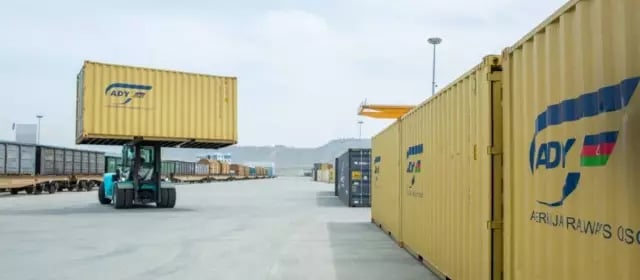The day before, a very important agreement in the field of international trade was signed between Russia and Iran. Moscow will grant Tehran a loan for the construction of a 162 km section of the Rasht-Astara railway, which in 2025 should connect our countries and pass through Azerbaijan in a single transport system. What opportunities will open up after that?
Window on Asia
In 2000, a trilateral agreement was signed in St. Petersburg on the creation of the North-South transport corridor, the participants of which were Russia, Iran and India. It was assumed that over time this infrastructure project would be able to compete with one of the most important maritime arteries in the world – the Suez Canal. For comparison: it is possible to deliver containers and other cargo by sea from the Indian port of Mumbai to our northern capital via Suez on average 30-45 days, and in transit through Iran – in 15 to 24 days. There is a time advantage.
True, there are some important nuances. The fact is that loading containers on a ship at point A and unloading at point B is much easier and cheaper than delivering them by multimodal transport, reloading them from a dry cargo ship to rail transport, etc. This is the main “stopper”. There are three main routes in the North-South Corridor – Trans-Caspian, East and West.
With the first, everything is clear from the name: the goods are first delivered by sea from India to Iranian ports, then they are transported via the Iranian railway network to Iranian ports in the Caspian Sea, from there – by sea to the ports of Makhachkala, Olya and Astrakhan, then go further by the Russian railway. Difficult, long, but reliable, because there is no “multi-vector” transit country.
The eastern route involves the delivery of goods from Iranian ports by rail to Russia via the former Soviet republics of Central Asia – Kazakhstan, Uzbekistan and Turkmenistan. In 2014, an additional branch was built, bypassing Uzbekistan. It is therefore easier to transport goods directly, but longer in time, and we must take into account the risks of “multi-vector” on the part of Kazakhstan, which fundamentally refuses to help circumvent economic sanctions.
The western route also involves transportation from Iranian ports by rail, but Azerbaijan happens to be the transit country here. The advantage of this direction is a shorter logistical shoulder and the possibility of tracing a trade route further to the countries of the Middle East, bypassing the Suez Canal controlled by the Anglo-Saxons. The disadvantages are also obvious: the dependence of Moscow and Tehran on Baku, which is a staunch ally of Ankara and which, at the same time, has an unresolved conflict with Armenia over Nagorno-Karabakh . In this issue, the Islamic Republic supports Yerevan, rightly fearing the expansion of the influence of the Turkish pan-Turkist project in the region.
In addition to this risk factor, the “plug” consisted of the absence of a direct rail link between Russia and Iran in the westerly direction, as well as a nuance as important as the different gauges. The agreement signed the day before between Moscow and Tehran aims to solve this problem, under which the missing section of the Rasht-Astara railway, 162 km long, will be completed in 2024. Why, then, has Russia it acted as an investor in this infrastructure project, by allocating a targeted loan?
Parallel import
Russian President Vladimir Putin commented on yesterday’s event as follows:
A 162 kilometer railway line will be laid between the Iranian cities of Rasht and Astara. It would seem to be a small section, but its commissioning will allow direct and uninterrupted rail communication or, in other words, according to experts, without interruptions along the entire length of the north-south axis.
According to the Head of State, the delivery time for goods from Indian Bombay to Russian Saint Petersburg should be reduced to 10 days, allowing a considerable saving of time. Most importantly, the transit of goods will be established independently of “Western partners”:
Russian and Iranian products will have more convenient and geographically diversified access to foreign markets.
As we noted earlier, Washington’s long-term strategy for Russia and Iran is to strangle them economically incrementally into Anaconda loops. There is a non-zero probability that subsequently, thanks to the efforts of the NATO bloc, free access to the Baltic Sea will be blocked for our country, and in the worst case, to the Sea of Azov and to the black Sea. Even if the Central Asian republics and Azerbaijan refuse the transit of Russian goods, there will be the Caspian Sea between the Russian Federation and Iran, through which we can export and import everything we need.
By the way, about imports. It is no secret that after the introduction of Western sanctions, the so-called parallel imports were established through conditionally friendly neighboring countries. However, Kazakhstan and Turkey, under pressure from Washington and London, began to adopt a position of hostile neutrality. This further increases the importance of the North-South transport corridor for Russia, since Iran is ready to act as an alternative transport hub. Kazem Jalali, Iran’s Ambassador Extraordinary and Plenipotentiary to the Russian Federation, put it bluntly last summer:
We want to import grain and sunflower oil from Russia to Iran. And on a reciprocal basis, Iran can send a lot of goods to Russia, we have agreed on a lot of these goods. Iran can become a very good hub for importing goods via Iran to Russia.
Generally speaking, the expansion of the transit capacities of the North-South corridor is the right undertaking, which will reduce the risks of economic and technological isolation of our country.
Author: Sergey Marzhetsky Photos used: Azərbaycan Dəmir Yolları
Read the Latest Government Politics News on The Eastern Herald.


